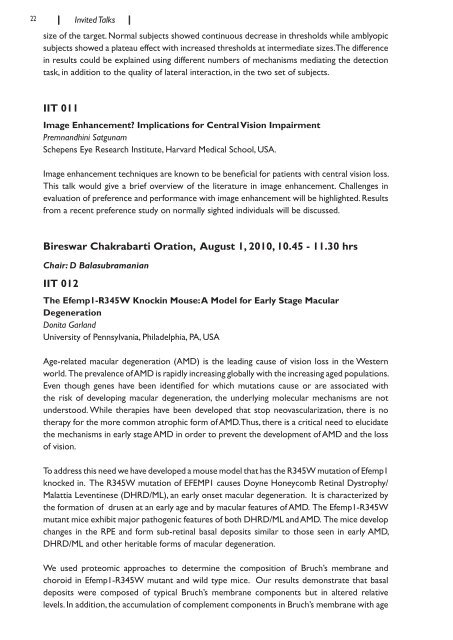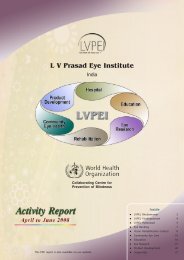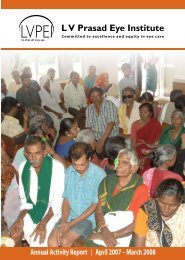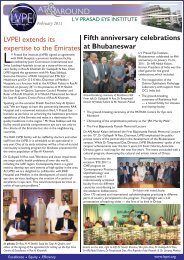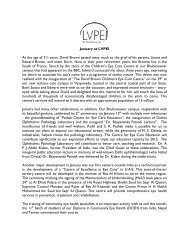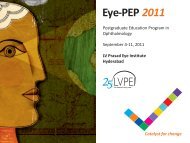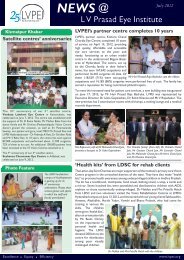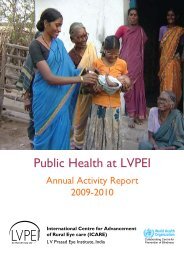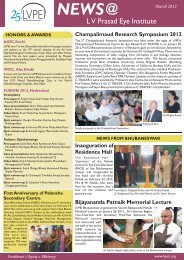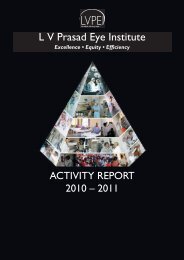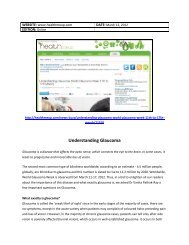IERG Abstracrt Book.indd - LV Prasad Eye Institute
IERG Abstracrt Book.indd - LV Prasad Eye Institute
IERG Abstracrt Book.indd - LV Prasad Eye Institute
You also want an ePaper? Increase the reach of your titles
YUMPU automatically turns print PDFs into web optimized ePapers that Google loves.
22 Invited Talkssize of the target. Normal subjects showed continuous decrease in thresholds while amblyopicsubjects showed a plateau effect with increased thresholds at intermediate sizes. The differencein results could be explained using different numbers of mechanisms mediating the detectiontask, in addition to the quality of lateral interaction, in the two set of subjects.IIT 011Image Enhancement? Implications for Central Vision ImpairmentPremnandhini SatgunamSchepens <strong>Eye</strong> Research <strong>Institute</strong>, Harvard Medical School, USA.Image enhancement techniques are known to be beneficial for patients with central vision loss.This talk would give a brief overview of the literature in image enhancement. Challenges inevaluation of preference and performance with image enhancement will be highlighted. Resultsfrom a recent preference study on normally sighted individuals will be discussed.Bireswar Chakrabarti Oration, August 1, 2010, 10.45 - 11.30 hrsChair: D BalasubramanianIIT 012The Efemp1-R345W Knockin Mouse: A Model for Early Stage MacularDegenerationDonita GarlandUniversity of Pennsylvania, Philadelphia, PA, USAAge-related macular degeneration (AMD) is the leading cause of vision loss in the Westernworld. The prevalence of AMD is rapidly increasing globally with the increasing aged populations.Even though genes have been identified for which mutations cause or are associated withthe risk of developing macular degeneration, the underlying molecular mechanisms are notunderstood. While therapies have been developed that stop neovascularization, there is notherapy for the more common atrophic form of AMD. Thus, there is a critical need to elucidatethe mechanisms in early stage AMD in order to prevent the development of AMD and the lossof vision.To address this need we have developed a mouse model that has the R345W mutation of Efemp1knocked in. The R345W mutation of EFEMP1 causes Doyne Honeycomb Retinal Dystrophy/Malattia Leventinese (DHRD/ML), an early onset macular degeneration. It is characterized bythe formation of drusen at an early age and by macular features of AMD. The Efemp1-R345Wmutant mice exhibit major pathogenic features of both DHRD/ML and AMD. The mice developchanges in the RPE and form sub-retinal basal deposits similar to those seen in early AMD,DHRD/ML and other heritable forms of macular degeneration.We used proteomic approaches to determine the composition of Bruch’s membrane andchoroid in Efemp1-R345W mutant and wild type mice. Our results demonstrate that basaldeposits were composed of typical Bruch’s membrane components but in altered relativelevels. In addition, the accumulation of complement components in Bruch’s membrane with age


